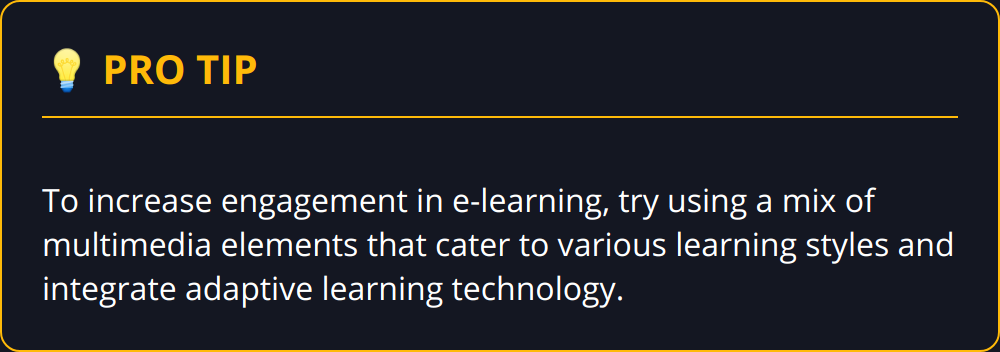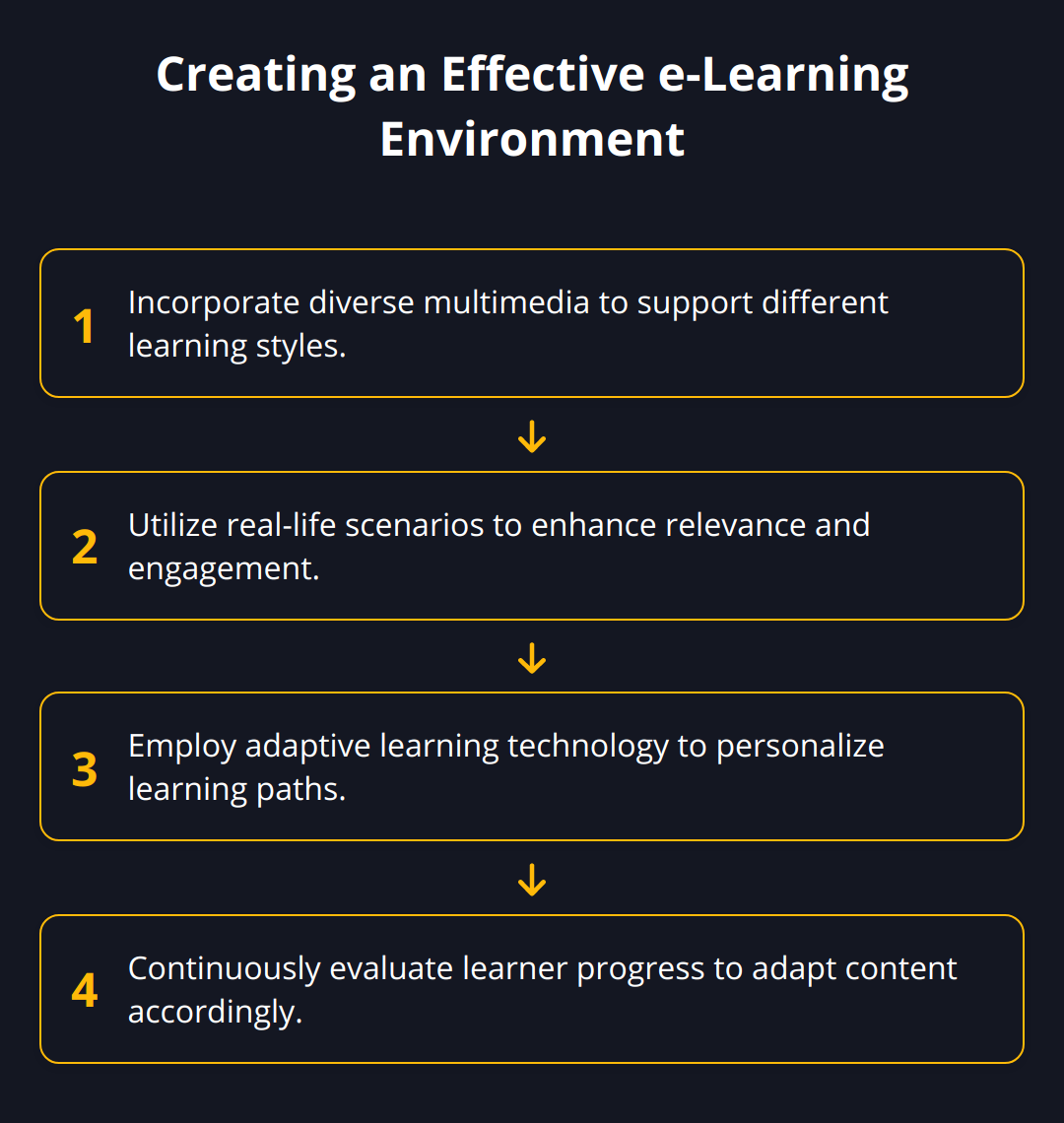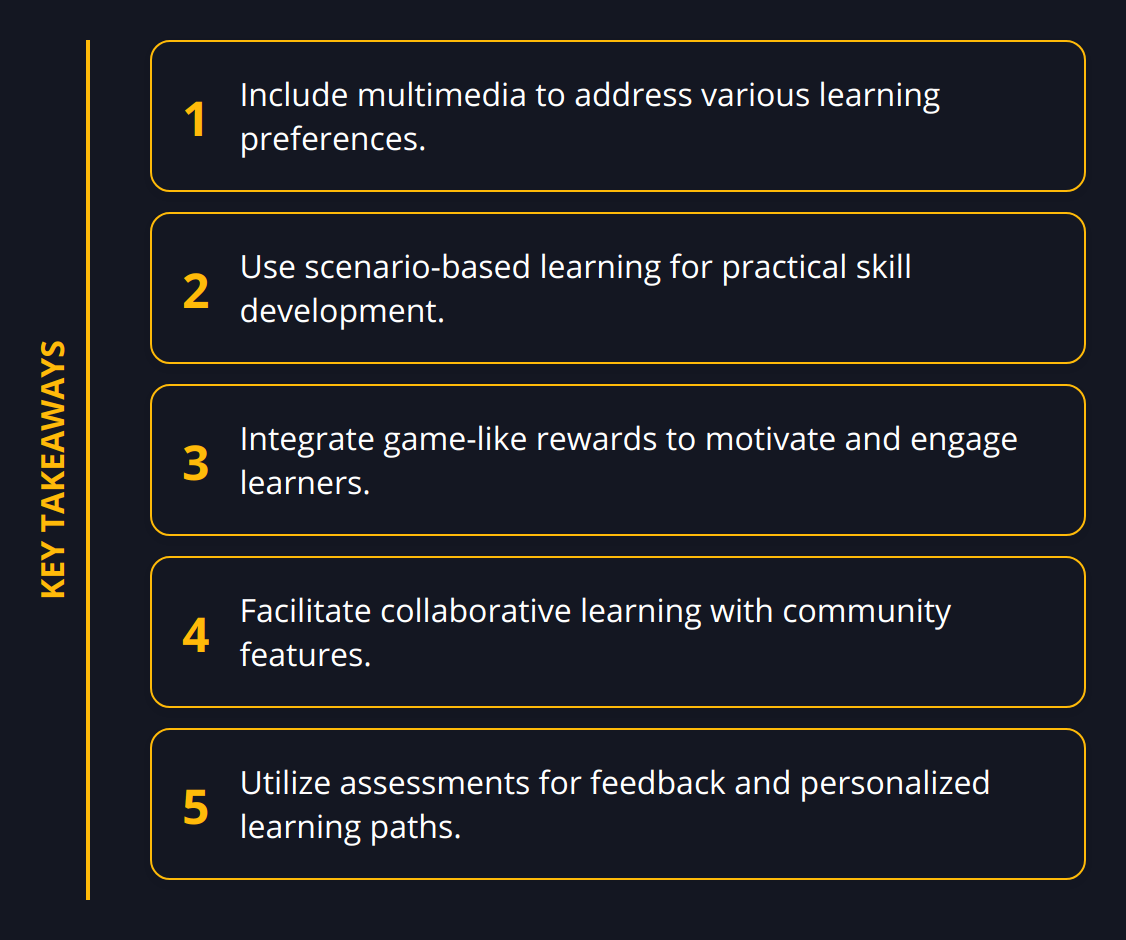E-learning has transformed education, offering flexibility and access like never before. We at newroom connect recognize that the effectiveness of digital learning hinges on the interactivity of course modules.
A well-designed interactive module can captivate learners, personalize their educational journey, and empower them with real-world skills. This article explores the core features that drive the success of these interactive learning tools.
Engaging Through Interactivity
In the realm of e-learning, the success of an interactive module is deeply intertwined with its ability to immerse users through thoughtful design and multimedia integration. Studies indicate that learners retain 25%-60% more information when engaged through interactive e-learning than with traditional methods. Taking this into account, an effective module must create an environment where every audio clip, video, and graphic serves not only to present information but to involve the learner in the learning process. A balance of text, audio, and visual elements caters to different learning styles and keeps engagement high.
Personalizing the educational experience is equally significant. Modules that resonate on a personal level with learners can vastly improve retention and application of new knowledge. By incorporating scenario-based learning, particularly with real-life examples relevant to the learner’s goals and challenges, modules can impact performance more significantly. A module on workplace safety, for instance, should include simulations that mirror the actual work environment for learners to practice and test their skills.
Furthermore, the journey through an e-learning course should adapt to the unique pace and capability of each learner. Adaptive learning technology, using learner responses to tailor the difficulty and topics of modules, ensures that each path taken is as unique as the individual. This not only supports better learning outcomes but does so in a more efficient and user-centric manner. In fact, when adaptive learning strategies are employed, engagement can improve by up to 50%.

Here’s how to ensure an interactive module delivers:
-
Offer a mix of multimedia to cater to various learning styles.
-
Integrate real-life scenarios that are directly applicable to the learner’s context.
-
Design learning paths that evaluate and adapt to individual progress.
For instance, the incorporation of adaptive e-learning tools represents a significant leap forward in customization, enabling educational materials to dynamically alter themselves to suit the learner’s progress and proficiency levels.

Educational content is not one-size-fits-all, and by embedding these characteristics into module designs, interactive e-learning can significantly improve knowledge acquisition, retention, and the overall learning experience.
Maximizing Learner Engagement
Interactive e-learning hinges on active participation. It’s the magnet that draws learners into the educational sphere and keeps them captively navigating through coursework. Let’s get to the heart of how to elevate engagement and bolster learning efficacy.
Gamification has stormed the scene as a power player in learner motivation. Integrating elements typical of game play, such as points, badges, or leaderboards, stirs a sense of competition and accomplishment. Providing these rewards for completing tasks or mastering concepts can boost completion rates and encourage continued engagement. This isn’t just speculation; statistics bear witness to the significant impact of gamification on learning. For example, incorporating reward systems led to a reported 90% increase in student performance. That’s a figure educators and instructional designers cannot afford to ignore.

Real-world application is another foundation stone for interactive learning. Presenting learners with scenarios and case studies they’re likely to encounter in their professional lives isn’t simply handy—it’s transformative for learning. The scenario-based approach translates theoretical knowledge into practical skills, effectively preparing learners for real-life challenges. Imagine a sales training module with customer interaction simulations. Learners get to test-drive various strategies, see immediate outcomes, and refine their approach—all within the safety of a virtual environment.
Social learning shouldn’t be underestimated either. No man is an island, and no learner should be alone in an online course. Integrating community features like discussion boards or group projects can foster a collaborative learning ecosystem.

Here are quick-hit strategies to ensure your e-learning modules keep learners glued:
-
Design your modules with points and achievement badges. These elements encourage a profound sense of progress.
-
Embed real-life case studies relevant to your audience’s field to bolster the application of knowledge.
-
Cultivate online communities where learners can interact, discuss, and grow together.
-
Employ virtual reality tools for realistic scenario-based learning environments.
-
Make it mobile-friendly. Flexibility in access is no longer a luxury; it’s expected.
As technology strides forward, so do the possibilities for making e-learning modules more engaging and effective. The innovative use of gamification elements, case-based learning, and social connectivity are pivotal in crafting educational experiences that resonate with learners and yield tangible outcomes. With these strategies, we ensure that learners don’t just take courses—they experience them.
Powering Progress with Assessment
Effective e-learning isn’t just about what you learn, it’s also about how well you can measure that learning. Assessment is the engine behind this, driving learners to not only gauge their understanding but to receive the fuel needed to power on—valuable feedback. Testing shouldn’t be an event that occurs only at a module’s end but an ongoing process that informs both the learner and the educational platform.
Regular self-assessments are vital. They give learners the ability to check in on their progress, reinforcing their knowledge and highlighting areas needing further attention. When learners engage in these frequent checks, they are more likely to retain information and build confidence. It’s not about high-stakes testing, which can be stress-inducing, but about ensuring a continuous loop of evaluation that carries the learner forward.
Equally important is the feedback that follows assessment. It must be constructive, providing clear guidance on how to improve, rather than just a score. This feedback transforms mistakes into impactful learning experiences. Imagine a scenario where a learner receives a suggestion for a resource that addresses the exact difficulty area revealed in their recent quiz. This targeted approach can forge a path to deeper understanding and skill mastery.
Leveraging data is the key to creating a personalized learning experience. Assessment results yield a wealth of insight into how a learner is performing. With the right tools, this data can lead to tailored content recommendations and adaptive learning pathways personalized to each user’s needs. For example, if data shows a learner excelling in one area but straddling behind in another, the course can automatically provide more advanced materials for the former and revision resources for the latter.

Here are actionable insights to harness the power of assessment in e-learning:
-
Implement assessments not just as finals but as checkpoints throughout the learning path.
-
Design feedback to be actionable, making it clear what the next steps for improvement are.
-
Use assessment data to adjust learning pathways and resources to each individual’s progress and proficiency.
Modules that include feedback mechanisms become powerful tools that do more than educate—they coach, mentor, and guide. They turn learning into a two-way street, where the system learns about the learner just as the learner gains from the system. This harmonious exchange is what makes interactive e-learning modules more than educational tools—they’re partners in the learning journey.
Following these practical steps ensures that e-learning is not just an activity but an efficient, ongoing cycle of learning, assessment, and improvement, leading to stronger outcomes and a more engaged learner. This cycle is essential for e-learning to be effective and for learners to achieve their true potential.
Final Thoughts
Interactive elements are the heartbeat of modern e-learning modules. They breathe life into materials that might otherwise sit flat and dormant on a computer screen. This vitality is key for learner engagement, retention, and satisfaction, driving better outcomes across the board. We have seen that when e-learning is interactive, robust, and responsive to the learner’s needs, the results are consistently positive.

The conversation around e-learning doesn’t end once the interactive module is deployed. It is a landscape in constant evolution, and the push for continuous improvement in the digital learning space is relentless. With technologies developing at a lightning-fast pace, e-learning can only stay relevant and effective if it adapts and grows. This means regular updates to content and methodology, integrating the latest tech innovations, and always seeking feedback for refinement.
We at newroom connect understand the transformative power of e-learning. That’s why we’ve designed our software platform to be the perfect tool for launching immersive virtual experiences. Whether you’re looking to enhance educational outcomes or captivate customers with rich virtual spaces, newroom connect is equipped to meet the challenge. By choosing our intuitive platform for your e-learning modules, you are not only investing in quality education but also in the immense potential of virtual engagement.
Promoting the adoption of these state-of-the-art interactive modules will only further revitalize the learning process. With learners demanding more tailored, engaging educational experiences, educators and organizations cannot afford to lag. The successful integration of interactive modules lays the groundwork for not just enhanced learning outcomes but also for the development of a more skilled, prepared workforce and an enlightened society at large.
Discover the possibilities with newroom connect and make the leap towards exceptional virtual training and events. By leveraging the capabilities of our software, you can truly transform how you engage, educate, and inspire learners around the globe.
-
Keep content dynamic and regularly refreshed
-
Embrace technology updates to enhance learning tools
-
Gather and apply feedback for continuous module improvement
-
Encourage interactive module adoption for next-level educational experiences


